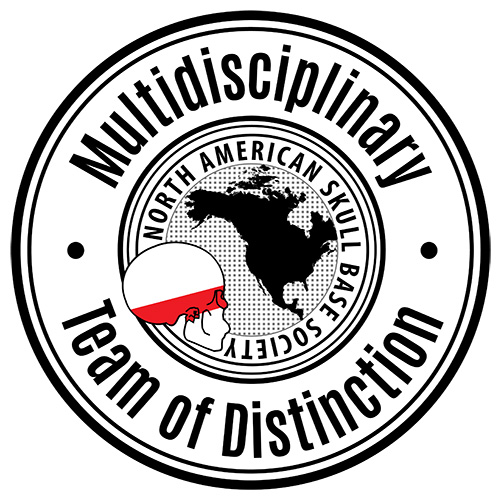Pterional Craniotomy and Extended Skull Base Approaches
(Orbitozygomatic Osteotomy)
The pterional craniotomy is a unique approach that provides wide access to the skull base. It is named after the pterion, the junction point of 4 bones within the skull (frontal, temporal, greater wing of sphenoid, parietal) and is considered a fundamental tool in the armamentarium of the neurosurgeon. It serves as a standard approach to the middle cranial fossa, anterior cranial fossa, suprasellar and parasellar structures, and Circle of Willis. When indicated, it can be combined with orbitozygomatic (OZ) osteotomy to provide even wider exposure. The pterional craniotomy is the approach of choice for resection of laterally-based skull base tumors (meningiomas, schwannomas, epidermoids, dermoids, fibrous dysplasia, orbital tumors, arachnoid cysts and brain malignancies) and clipping of cerebral aneurysms (both ruptured and unruptured).
For laterally-based tumors, the pterional approach minimizes brain retraction and provides the shortest distance to much of the superficial skull base and brain. Additionally, it offers a multidirectional view of the lesion which can allow for safer surgical manipulation. To minimize complications and maximize patient safety, intraoperative image navigation is used for customized incision and craniotomy planning, exact tumor location and avoidance of large underlying blood vessels. Finally, intraoperative neurophysiological monitoring [electroencephalogram (EEG), somatosensory evoked potentials (SEPs), electromyography (EMG) and brain stem auditory evoked potentials (BSAERs)] is fundamental for avoiding intraoperative complications.
The skin incision is hidden behind the hairline and the bone is replated carefully to guarantee excellent cosmetic results and fast recovery.
All of the cranial neurosurgeons at the University of Pittsburgh use the pterional approach routinely for many different kinds of pathologies.
The concept of team surgery has allowed our center to expand the role of pterional craniotomy to include extensive skull base tumors; in these cases, an extended pterional approach is combined with orbital or orbitozygomatic osteotomy. Having mastered endoscopic skull base approaches in our center, endoscopic- assisted tumor resection during a pterional craniotomy is often used for better visualization and additional tumor resection.
Retromastoid Craniectomy (RMC)
The RMC is a minimally invasive approach to the posterior cranial fossa, pontocerebellar angle (PCA) for removal of skull base tumors (acoustic neuroma, meningioma, epidernoid, dermoid, arachnoid cyst, brain malignancies and metastatic disease) and microvascular decompression of cranial nerves (trigeminal neuralgia, hemifacial spasm, geniculate neuralgia, glossopharyngeal neuralgia, torticollis).
The patient is placed in a lateral decubitus position and a small incision is made behind the ear followed by a small amount of bone removal. With minimal or no brain retraction and the use of both microscope and endoscope, the skull base lesion, cranial nerves and vessels are seen and the problem can be repaired with efficiency and safety.
The University of Pittsburgh has a long history pioneering the RMC and it remains a very busy center for treatments of PCA tumors and microvascular decompression via RMC. Image-guided intraoperative navigation and neurophysiological monitoring [electroencephalogram (EEG), electromyogram (EMG), somatosensory evoked potentials (SEPs), brain stem auditory evoked potentials (BASERs)] are used routinely for the most efficient and safe results.
To learn more about RMC, please visit the Understanding Retromastoid Craniectomy page on the UPMC.com website.
Cranial Base physicians have been using the RMC for many years with excellent results that have been advanced by the introduction of the endoscope to better visualize and approach the tumors and the cranial nerves.
Open Approaches to the Skull Base: C2 Rhizotomy
This surgical approach is used primarily to treat medically refractory occipital neuralgia. Occipital neuralgia can follow surgery, trauma, be associated with bony anomalies and can be idiopathic. The surgical target is to perform a posterior cervical C1 hemilaminectomy to access the C2 dorsal nerve roots for selective rhizotomy. This can provide relief for neuropathic pain localized to the occiput.
The patient is placed in a fixed head holder then placed prone on the operating room table. The head is kept in the midline position and maximally flexed as the patient’s anatomy will allow. This widens the exposure above and below the lamina of C1.
A midline posterior cervical incision is used. Once the unilateral exposure is completed, removal of the ipsilateral C1 lamina is performed. This allows access to the cervical dura at the level of the C2 nerve roots. The dura is opened in the middle of the exposure to expose the lateral spinal cord and dorsal exiting roots. The C2 dorsal nerve roots are carefully selected and ligated. The dura is then sutured watertight to prevent a spinal fluid leak. The posterior cervical incision is then closed.
A recent study from our institution found that 84% of patients received some degree of relief with the vast majority getting complete relief of their pain, regardless of etiology.

